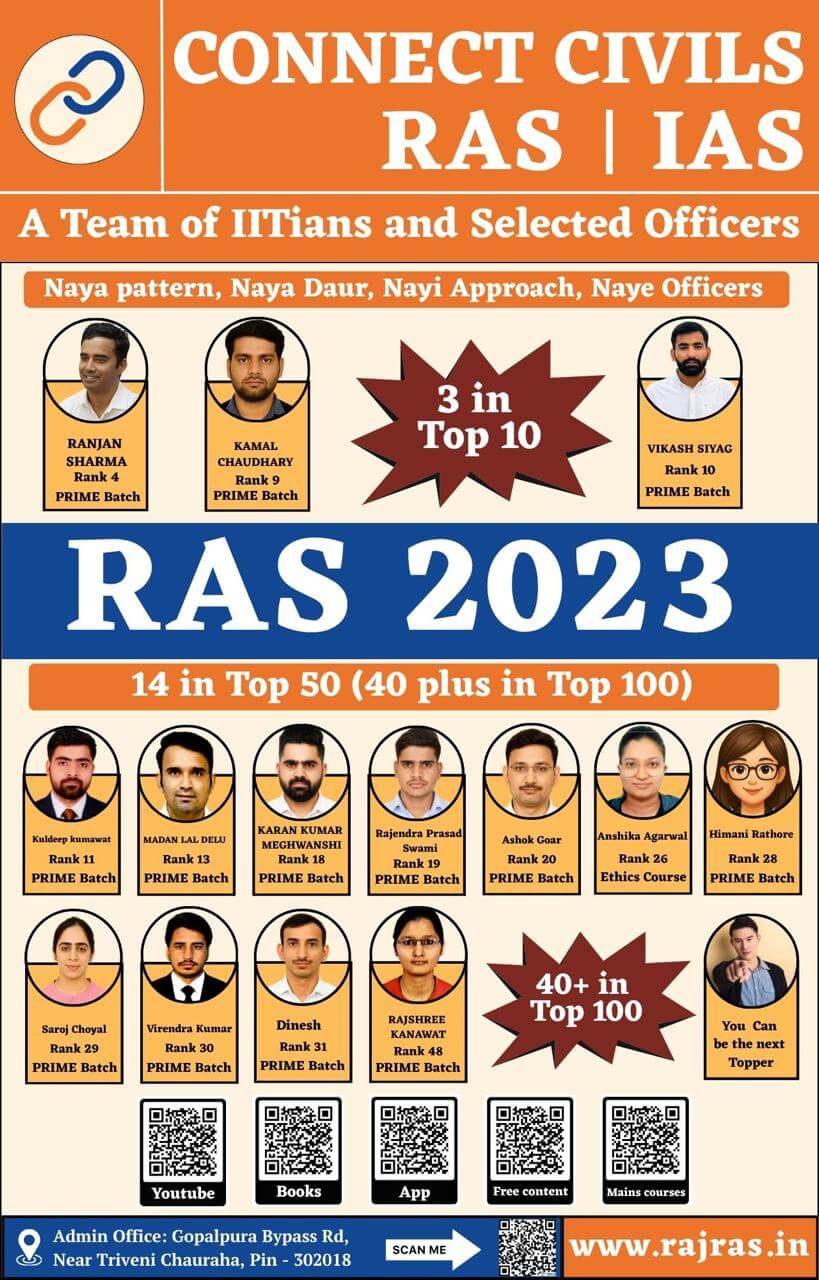Rajasthan During Vedic Period marks a significant phase in the evolution of culture and society in ancient Rajasthan. In the context of Rajasthan History, this period reflects the transition from tribal pastoral life to settled agriculture, the emergence of social hierarchies, and early religious practices. References in Vedic texts also highlight the presence of important tribes and settlements in this region.
Rajasthan During Vedic Period (1500 BC–500 BC)
The cities of the Harappan Culture had declined by 1500 B.C. Around this period, the speakers of the Indo-Aryan language, Sanskrit, entered north-west India from the Indo-Iranian region. Initially they would have come in small numbers through the passes in the northwestern mountains. Their initial settlements were in the valleys of the north-west and the plains of the Punjab. Later, they moved into Indo-Gangetic plains. As they were mainly cattle-keeping people, they were mainly in search of pastures. By 6th century B.C., they occupied the whole of North India, which was referred to as ‘Aryavarta’. The original home of the Aryans is a debatable question and there are several views. This period between 1500 B.C and 600 B.C may be divided into:
- The Early Vedic Period or Rig Vedic Period (1500 B.C -1000 B.C)
- The Later Vedic Period (1000B.C – 600 B.C)
The Early Vedic Period (1500 B.C -1000 B.C)
- Location:
- During the Rig Vedic period, the Aryans were mostly confined to the Indus region.
- The Rig Veda refers to Sapta sindhu which includes 5 rivers of Punjab (Jhelum,Chenab, Ravi, Beas and Sutlej) along with Indus and Saraswati.
Political System :

- There were several tribal kingdoms during the Rig Vedic period such as Bharatas, Matsyas ,Yadus and Purus. The head of the kingdom was called a rajan or king.
- The Rig Vedic polity was normally monarchical and the succession was hereditary. The king was assisted by purohita or priest and senani or commander of the army in his administration.
- There were two popular bodies called the Sabha and Samiti. The Sabha seems to have been a council of elders and the latter, a general assembly of the entire people.
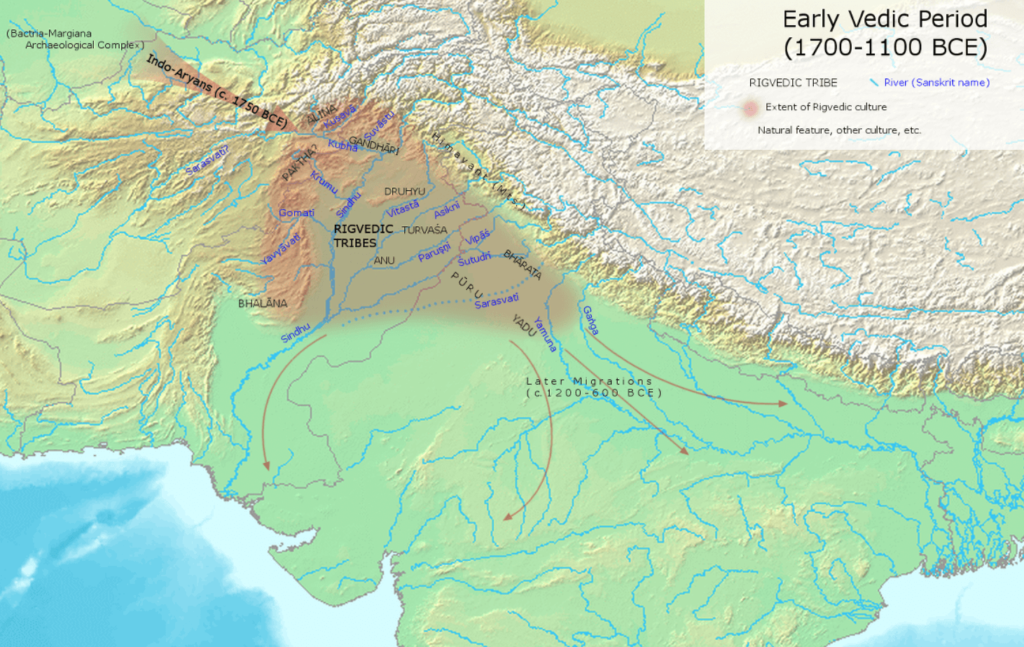
Social Life:
- Society – The Rig Vedic society was patriarchal. The basic unit of society was family or graham. The head of the family was known as grahapathi.
- Marriage – Monogamy was generally practiced while polygamy was prevalent among the royal and noble families.
- Gender equality : Women were given equal opportunities as men for their spiritual and intellectual development. For eg. Apala, Viswavara, Ghosa and Lopamudra were women poets during the Rig Vedic period. Women could even attend the popular assemblies, There was no child marriage and the practice of sati was absent.
- Chariot racing, horse racing, dicing, music and dance were the favourite pastimes.
- The social divisions were not rigid during the Rig Vedic period as it was in the later Vedic period.
Economic Condition:
- Main professions- Cattle rearing, agriculture, carpentry, spinning, pottery Trade
- The Rig Vedic Aryans were pastoral people and their main occupation was cattle rearing. Their wealth was estimated in terms of their cattle.
- When they permanently settled in North India they began to practice agriculture. With the knowledge and use of iron they were able to clean forests and bring more lands under cultivation.
- Carpentry was another important profession and the availability of wood from the forests cleared made the profession profitable. Carpenters produced chariots and ploughs.
- Workers in metal made a variety of articles with copper, bronze and iron.
- Spinning was another important occupation and cotton and woolen fabrics were made. Goldsmiths were active in making ornaments
- The potters made various kinds of vessels for domestic use.
- Trade was another important economic activity and rivers served as important means of transport. Trade was conducted on a barter system. In the later times, gold coins called nishka were used as media of exchange in large transactions.
Religion:
- The Rig Vedic Aryans worshiped the natural forces like earth, fire, wind, rain and thunder.
- The important Rig Vedic gods were Prithvi (Earth), Agni (Fire), Vayu (Wind), Varuna (Rain) and Indra (Thunder).
- There were also female gods like Aditi and Ushas.
- There were no temples and no idol worship during the early Vedic period
The Later Vedic Period or Iron Age (1000 – 600 B.C.)
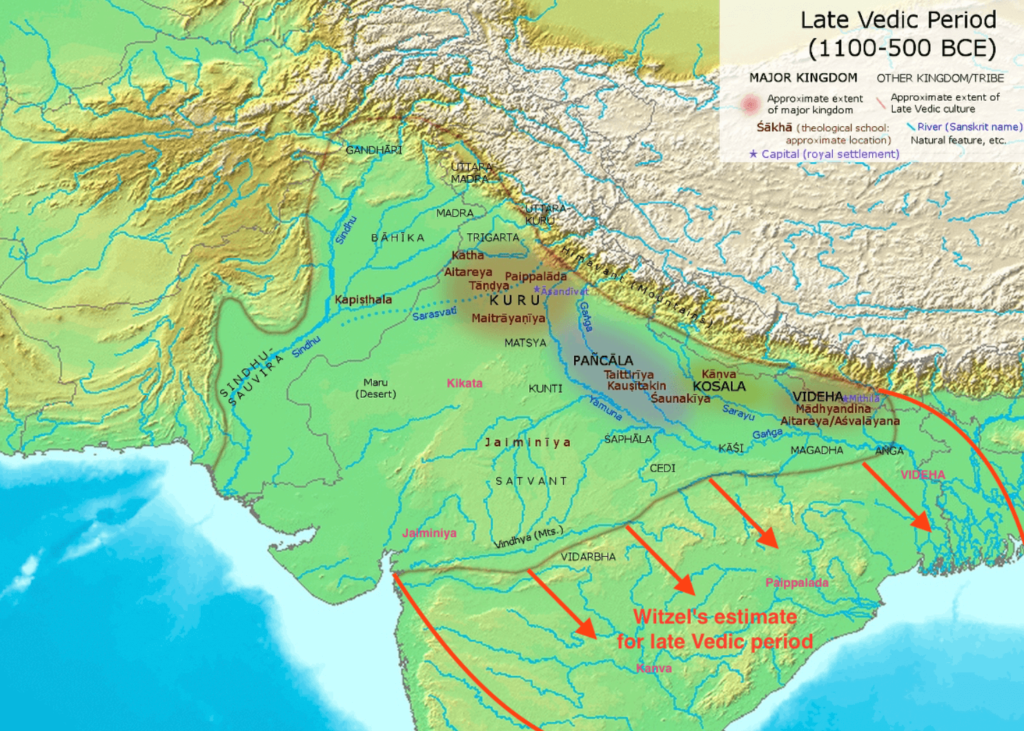
Location:
- The Aryans further moved towards east in the Later Vedic Period.
- The Satapatha Brahmana refers to the expansion of Aryans to the eastern Gangetic plains.
- Kuru and Panchala kingdoms flourished in the beginning. After the fall of Kurus and Panchalas, other kingdoms like Kosala, Kasi and Videha came into prominence.
- The later Vedic texts also refer to the three divisions of India – Aryavarta (northern India), Madhyadesa (central India) and Dakshinapatha (southern India).
Political System:
- Larger kingdoms were formed during the later Vedic period. Many jana or tribes were amalgamated to form janapadas or rashtras in the later Vedic period
- The king performed various rituals and sacrifices to strengthen his position. They include Rajasuya (consecration ceremony), Asvamedha (horse sacrifice) and Vajpeya (chariot race).
- The kings also assumed titles like Rajavisvajanan, Ahilabhuvanapathi, (lord of all earth), Ekrat and Samrat (sole ruler).
- In the later Vedic period, a large number of new officials (treasury officer, tax collector and royal messenger) were involved in the administration in addition to the existing purohita, senani and gramani.
- At the lower levels, the village assemblies carried on the administration. The importance of the Samiti and the Sabha had diminished during the later Vedic period.
Social System:
- The four divisions of society (Brahmins, Kshatriyas, Vaisyas and Sudras) or the Varna system was thoroughly established during the Later Vedic period.
- Position of women declined, they were still considered inferior and subordinate to men. Women also lost their political rights of attending assemblies.
- Child marriages had become common.
Economic Condition:
- Iron was used extensively in this period and this enabled the people to clear forests and to bring more land under cultivation.
- Metal work, leather work, carpentry and pottery made great progress. In addition to internal trade, foreign trade became extensive.
- Vaisyas also carried on trade and commerce. They organized themselves into guilds known as ganas.
- Besides Nishka of the Rig Vedic period, gold and silver coins like satamana and krishnala were used as media of exchange.
Religion:
- Gods of the Early Vedic period like Indra and Agni lost their importance
- Prajapathi (the creator), Vishnu (the protector) and Rudra (the destroyer) became prominent during the Later Vedic period.
- Sacrifices were still important, Priesthood became a profession and a hereditary one. The formulae for sacrifices were invented and elaborated by the priestly class. Therefore, towards the end of this period there was a strong reaction against priestly domination and against sacrifices and rituals.
- The rise of Buddhism and Jainism was the direct result of these elaborate sacrifices.
- Authors of Upnishad also turned away from the useless rituals and insisted on true knowledge (jnana) for peace and salvation.
Vedic Age or Iron Age in Rajasthan:
- From 1000 BC, Iron was used in Gandhara in Pakistan. Around the same time, use of iron appeared in eastern Punjab, Western UP and Rajasthan.
- The Vedic literature mentions the Matsyas and the Salvas as located near the river Saraswati and there is evidence to believe that by the close of the Vedic age Rajasthan had become fully colonized by the Vedic tribes.
- The relics of Painted Grey ware culture have been reported from the dried- up beds of Saraswati and Drshadvati rivers.
- There is also evidence of Painted Grey Ware (PGW) from Noh (Bharatpur), Jodhpura(Jaipur), Viratnagar (Jaipur) and Sanari (Jhunjhunu). These sites represent the growth of the Iron Age in Rajasthan.
Ancient Pottery Cultures of Rajasthan (2000 BC – 100 BC)
Pottery is like a time machine that helps us understand how people lived in ancient times. By studying different types of pottery, historians learn about the lifestyle, culture, and technology of past societies. In Rajasthan, pottery such as Ochre Colored Pottery (OCP), Black and Red Ware (BRW), Painted Grey Ware (PGW), and Northern Black Polished Ware(NBPW) give us clues about the people who lived here thousands of years ago. These pottery styles tell us about their daily lives, trade, and progress over time
Bright Red Ware (BRW)
- Time Period: 2000–1500 BCE.
- Features:
- Pottery with a bright red finish, made by hand or on a wheel.
- Simple designs, mainly associated with early agricultural and pastoral communities.
- Represents the transitional phase between the Chalcolithic and Iron Ages.
Ochre Colored Pottery (OCP)
- Time Period: 2000–1500 BCE.
- Characteristics:
- Coarse, red or ochre-colored pottery.
- Ill fired brics, Porous texture.
- Found alongside copper tools, linking it to the Copper Hoard Culture.
- Associated with early Rig Vedic practices and agricultural settlements.
- It is a representative of ‘Early Vedic period’.
- Key Site: Jodhpura (Jaipur) The site with the thickest OCP deposits (1.1 m).
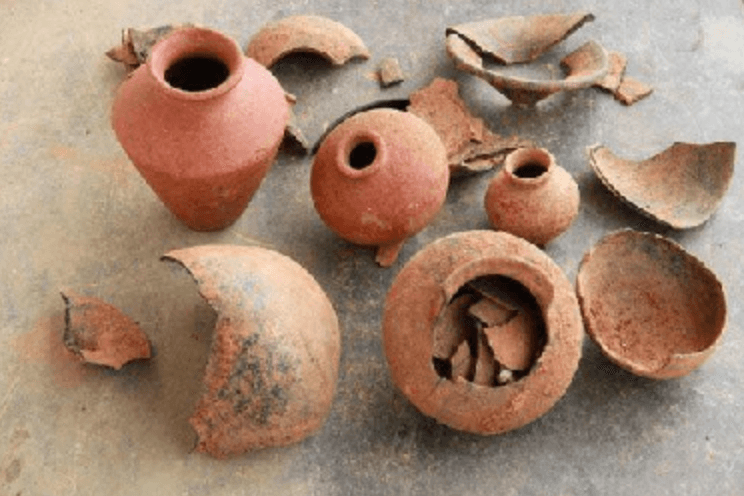
Black and Red Ware (BRG)
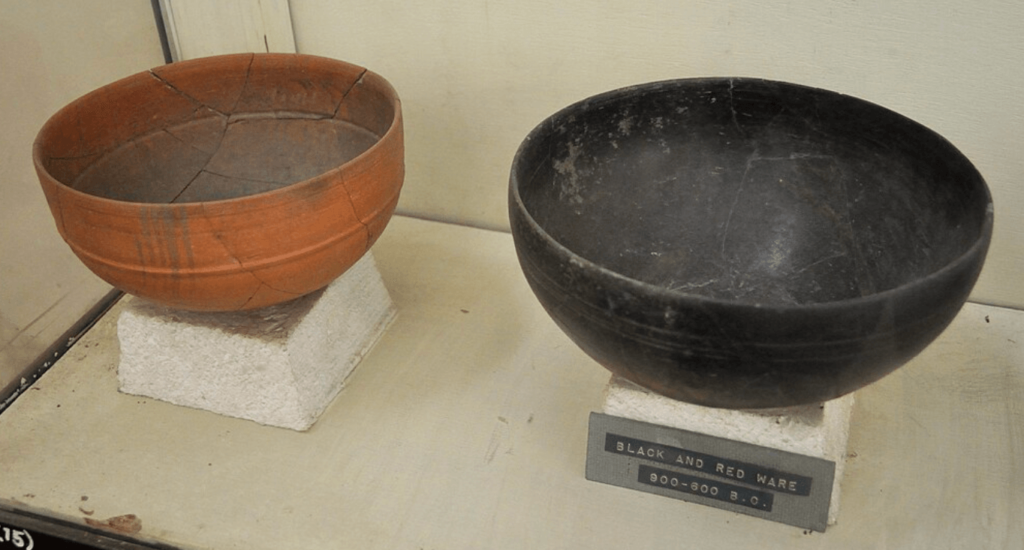
- Time Period: 1100–800 BCE.
- Characteristics:
- Black interior and red exterior pottery, often handmade.
- Simple designs, reflecting rural lifestyles.
- Black-and-Red Ware is found across different regions and time periods thus it cannot be tied to a specific time or culture.
Painted Grey Ware (PGW)
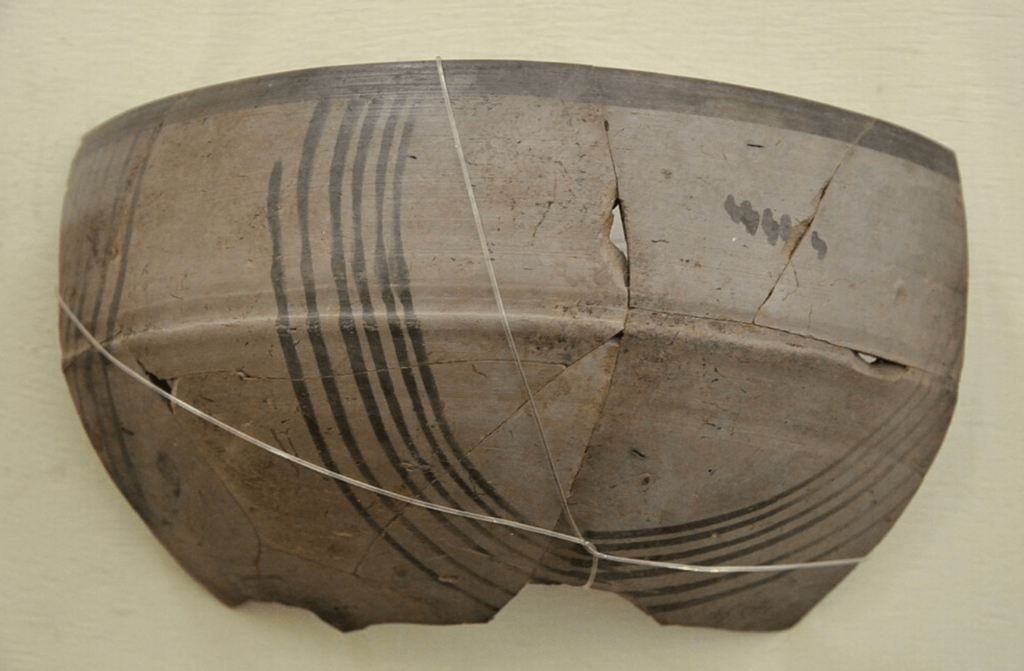
- Time Period: 800–400 BCE.
- Characteristics:
- Fine, grey pottery painted with black geometric patterns.
- Wheel-made, smooth surfaces, and associated with iron tools.
- Represents post-Vedic culture and early town planning.
- Key Sites:
- Noh and Jodhpura: Evidence of early iron metallurgy and organized settlements.
Northern Black Polished Ware (NBPW)
- Time Period: 800–100 BCE.
- Characteristics:
- Glossy, fine pottery used as elite tableware.
- Found with coins, crafts, and other evidence of urbanization.
- Significance:
- Symbolizes the Second Urbanization in India during the Mauryan period.
- Reflects advanced iron technology, trade, and socio-religious changes
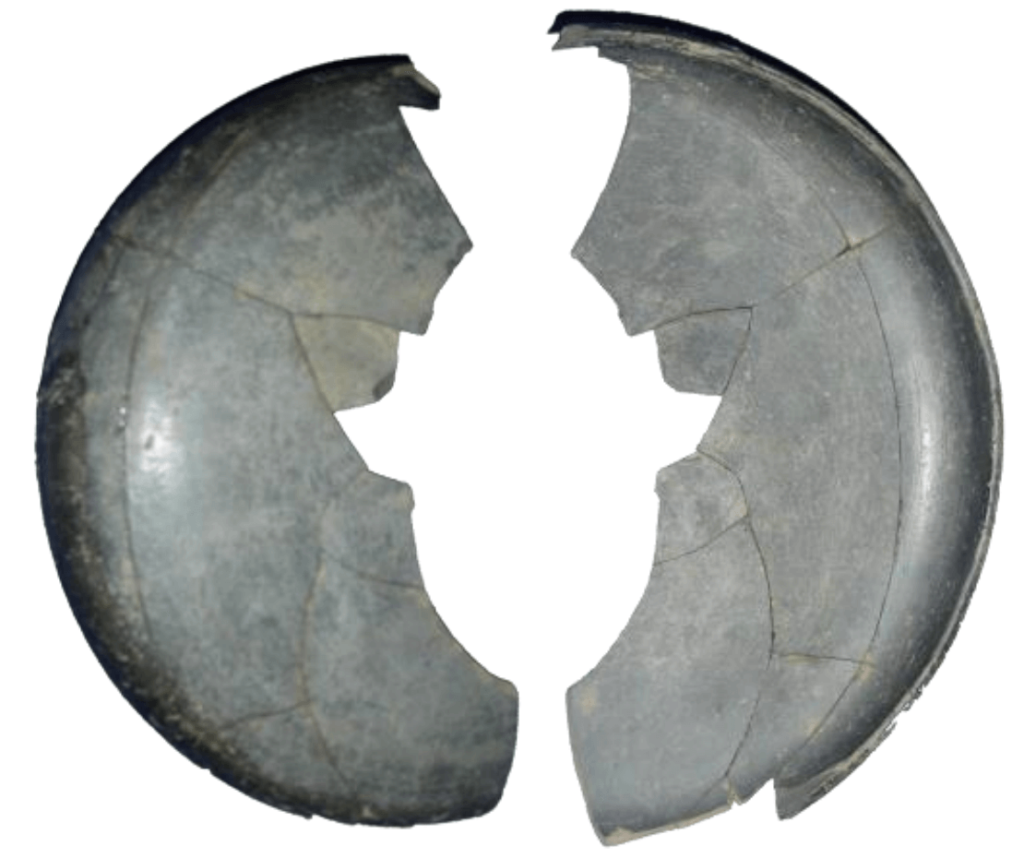
Evolution of Pottery- Quick revision
- Neolithic Age: Marked the beginning of handmade pottery.
- Chalcolithic Age: Diverse pottery types emerged, such as:
- Black-and-red-ware Pottery
- Black-on-red ware
- Ochre Coloured Pottery (OCP)
- Harappan Civilization:
- Pottery was mass-produced using the potter’s wheel.
- Techniques included slipping (coating with a thin layer of clay) and burnishing (polishing for a shiny finish).
- Painted Motifs: Designs included geometric patterns, floral and faunal motifs, and depictions of religious symbols.
- Types : Red ware, black-and-red ware, perforated pottery, and glazed pottery.
- Utility: Pottery was used for storage, cooking, and rituals.
- Vedic Era: Introduction of Painted Grey Ware (PGW), typically associated with early settlements.
- Later Vedic Era: Transition to Northern Black Polished Ware (NBPW), signifying advanced craftsmanship.
- End of Later Vedic Era: NBPW remained dominant, reflecting further refinement.

